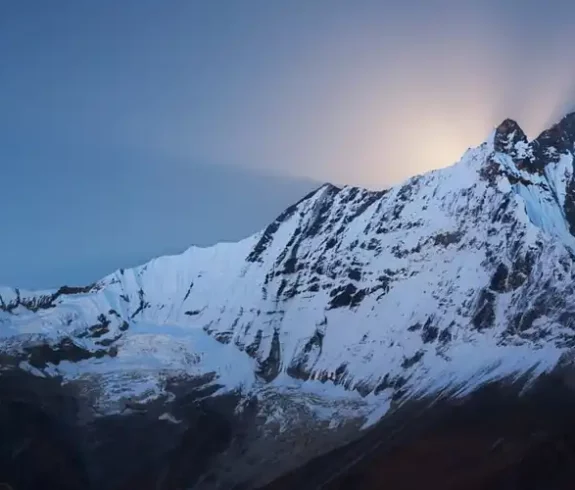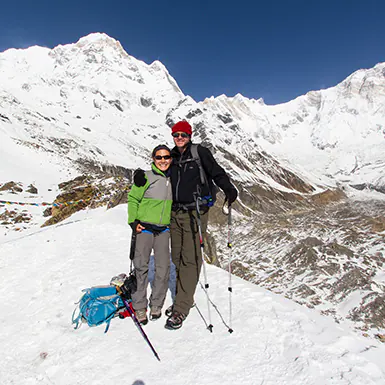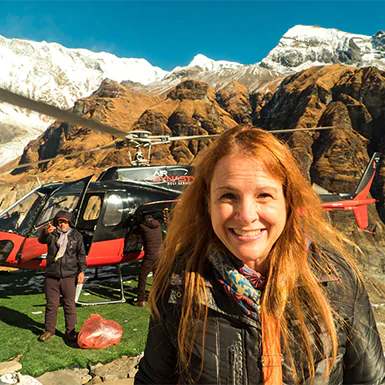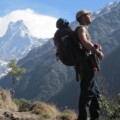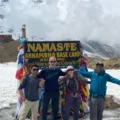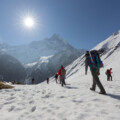Machapuchare Base Camp (MBC), situated deep within the Annapurna Sanctuary, is a treasured destination for trekkers and nature enthusiasts. This base camp, known for its stunning views and peaceful ambiance, plays a vital role in the Annapurna Base Camp trek. While it might be less famous than Annapurna Base Camp, this Base Camp provides a unique perspective of the Himalayas and a more serene connection with Machapuchare, the revered “Fish Tail” mountain.
The trekking community is highly valued for its unparalleled views and tranquil environment. Trekkers who make it to this point enjoy panoramic vistas, serene landscapes, and the rare experience of being near one of Nepal’s most sacred peaks. Since Machapuchare is considered holy, climbing it is prohibited, allowing its natural beauty and spiritual importance to remain intact.
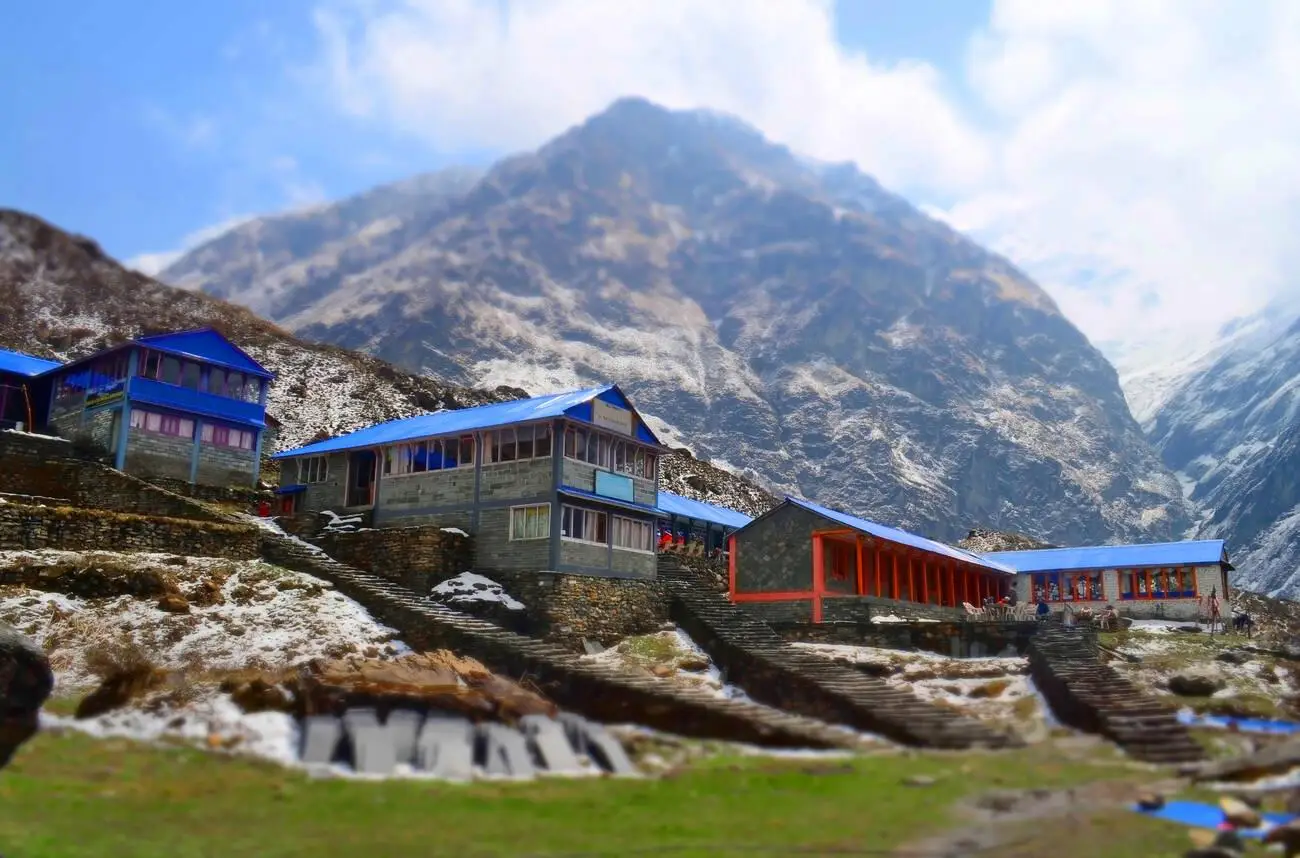
Location
- Located within the Annapurna Sanctuary, Machapuchare Base Camp is in the Annapurna Conservation Area, which is known for its rich ecological diversity.
- Integral to the Annapurna Base Camp Trek: This base camp is a crucial stop along the Annapurna Base Camp (ABC) trek, which starts in Pokhara and passes through scenic villages like Ghorepani and Chomrong.
- Close to Annapurna Base Camp: Trekkers usually reach this Base Camp a day before arriving at Annapurna Base Camp, making it an essential spot for acclimatization.
- Altitude: It is approximately 3,700 meters (12,139 feet) high, challenging trekkers but offering immense rewards.
- Access: The trek to Machapuchare Base Camp covers a route distance that varies based on the starting point, typically taking 5 to 7 days to reach from the beginning.
History and Mythology
Machapuchare Base Camp, revered within the Annapurna Sanctuary, carries a deep historical and mythological significance. This site transcends its popularity as a trekker’s haven to stand as a spiritual landmark within the local culture.
Local Legends and Historical Significance
The locals claim that Machapuchare, also known as the ‘Fish Tail,’ is the resting place of Lord Shiva, one of the most important gods in Hinduism. The mountain’s fishtail-like appearance is said to be Shiva’s eternal meditation retreat.
It makes Machapuchare a holy mountain, which many people highly respect. The local cultural life includes many legends about Machapuchare, which have been handed down from generation to generation.
Why Climbing is Prohibited
Authorities have declared Machapuchare a peak that no one can climb, honoring local cultural and spiritual values. Preserving this sacred mountain as an untouched natural wonder is a top priority for the local communities and the Nepalese government. The prohibition protects the hill’s ecological balance and upholds the cultural heritage that regards the peak as too sacred to be scaled.
The Significance of the Prohibition
The climbing ban at Machapuchare has boosted the popularity of Machhapuchhre Base Camp among global trekkers. Although trekkers reach the base camp at about 3,700 meters, the peak remains inviolate, adding to its mystique and allure. This policy preserves the integrity and beauty of Machapuchare, ensuring every visit respects the region’s natural and cultural splendor.
Trek Overview of Machapuchare Base Camp
Adventurers find the trek to Machapuchare Base Camp an extraordinary trek that merges the awe of natural beauty with rich cultural interactions. Starting in the vibrant city of Pokhara, this route leads through some of Nepal’s most breathtaking landscapes. As trekkers advance toward Machhapuchhre Base Camp, they navigate through dense forests, cross over thrilling suspension bridges, and visit the traditional villages of the Gurung and Magar communities.
Starting Points and Overall Experience
The adventure to MBC begins in Pokhara, Nepal’s renowned tourist center. From Pokhara, the path takes trekkers through scenic villages such as Ghandruk, Chomrong, and Deurali. These villages offer a deep dive into the local culture and hospitality, enriching the trekking experience. The trail meanders through terraced fields and thickets of rhododendrons and bamboo, climbing to higher elevations as it progresses.
Approaching Machhapuchhre Base Camp, the environment transforms dramatically. The lush vegetation gives way to rugged terrain and meandering glacial streams, while the towering peaks of the Annapurna range dominate the skyline. Anticipation heightens as trekkers near the base camp, where the iconic fish-tail peak of Machapuchare looms as a majestic guardian over the valley.
Connection to the Annapurna Base Camp Trek
It is pivotal in the broader Annapurna Base Camp Trek. Many trekkers push to Annapurna Base Camp after stopping at Machapuchare, only a few hours away. This proximity allows trekkers to soak in the tranquility of Machapuchare while also experiencing the majestic views of Annapurna.
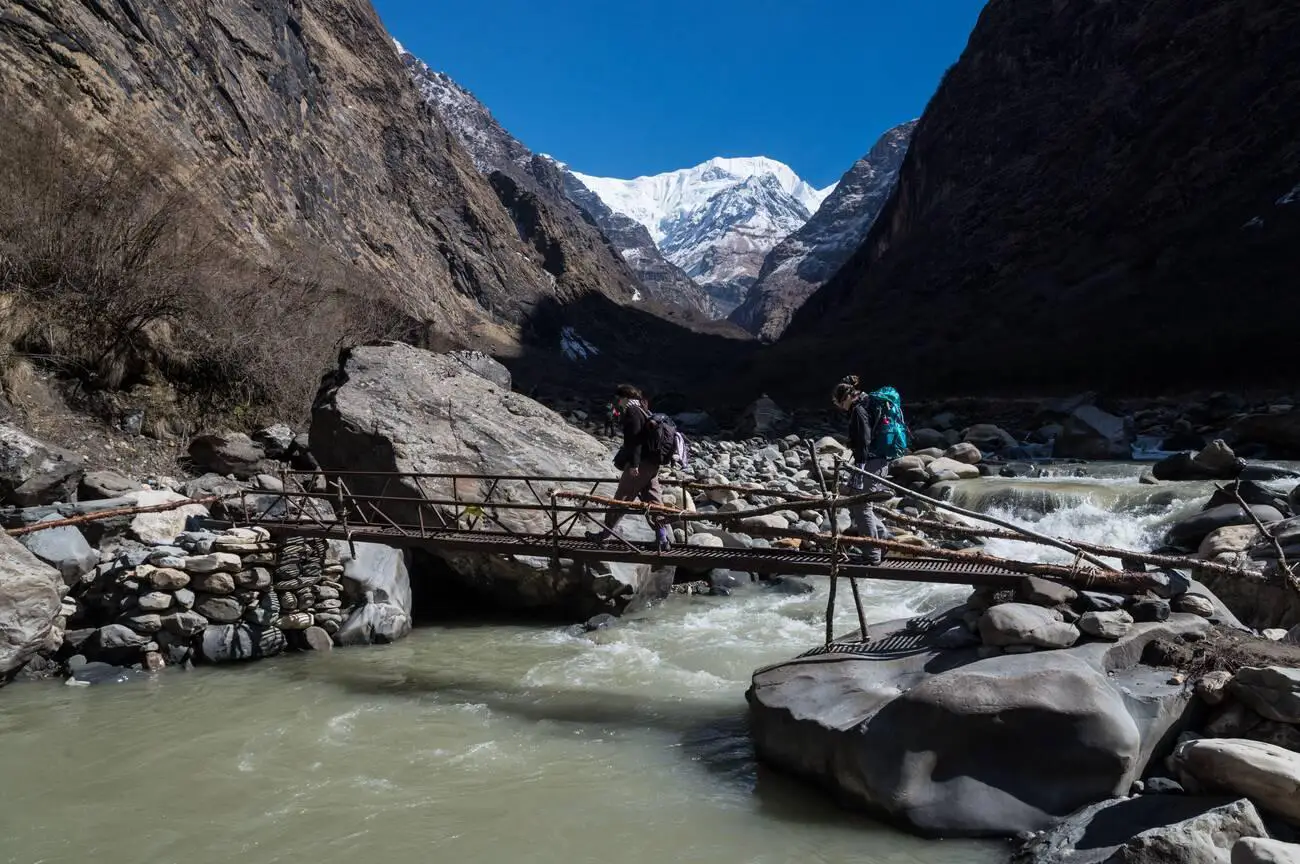
Route Details
The trek to Machapuchare Base Camp unfolds a captivating route filled with scenic landmarks and vital checkpoints that each trekker must experience. This trek challenges adventurers and rewards them with some of the most picturesque views in the Annapurna region.
Key Landmarks on the Trek
- Poon Hill: Starting at Poon Hill, trekkers often begin this segment early in the morning to catch the sunrise over the Himalayas. The view from Poon Hill provides a panoramic spectacle of both the Annapurna and Dhaulagiri ranges, setting an inspiring tone for the days ahead.
- Ghorepani: Next is Ghorepani, a charming village known for its vibrant magenta rhododendron forests, especially striking in the spring. Ghorepani serves as a cultural checkpoint where trekkers can interact with the local Gurung and Magar communities, gaining insights into their traditional lifestyles.
- Annapurna Base Camp: Many trekkers pass through Annapurna Base Camp before reaching Machhapuchhre Base Camp. This part of the trek offers a thrilling mix of excitement and apprehension as the altitude increases, revealing the raw beauty of the Annapurna Sanctuary.
Detailed Walkthrough
Starting from Pokhara, the trek to MBC goes through several stages. After enjoying the cultural and natural beauty of Ghorepani and Poon Hill, trekkers continue through dense forest paths leading to Tadapani and then to Chomrong. Chomrong is the last central village before the trail dives into the wilder zones of the Annapurna Sanctuary.
From Chomrong, the path splits, with one fork leading towards Annapurna Base Camp and the other veering towards Machapuchare Base Camp. The trek to Machhapuchhre Base Camp includes challenging ascents and rewarding descents, as well as navigating bamboo and alpine forests.
Machapuchare Base Camp Route Distance
The total distance from Pokhara to Machhapuchhre Base Camp is approximately 37 kilometers (23 miles). However, the trek needs to follow a straight line. Given the various ascents and descents along the path, the effective walking distance can feel much longer.
The trek usually spans several days, with most itineraries suggesting a 5 to 7-day trek to comfortably accommodate acclimatization and rest stops, especially in higher altitudes to manage the Machapuchare base camp altitude.
Altitude and Acclimatization
Trekking to Machapuchare Base Camp is an exhilarating adventure that takes you through varying elevations, culminating at the base camp’s significant altitude. Proper acclimatization is crucial to enjoying this trek safely and comfortably.
Altitude Details
Machhapuchhre Base Camp sits at an impressive altitude of approximately 3,700 meters (12,139 feet). The air is thinner at this height, and oxygen levels are lower. The “Machapuchare base camp altitude” poses challenges that trekkers must adequately prepare to avoid altitude sickness.
Acclimatization Tips
- Gradual Ascent: Increase your elevation slowly over several days to give your body time to adjust to the thinner air. Above 3,000 meters, avoid ascending more than 300-500 meters per day.
- Hydrate: Staying hydrated is crucial, as dehydration can exacerbate or mimic the symptoms of altitude sickness.
- Balanced Diet: A balanced diet containing ample carbohydrates can facilitate acclimatization. Carbohydrates are more manageable to metabolize at higher altitudes than fats and proteins.
- Avoid Alcohol and Smoking: Alcohol and tobacco can exacerbate altitude sickness and impair acclimatization, so it’s best to avoid them during the trek.
Managing Altitude Sickness
- Recognize Symptoms: Know the signs of altitude sickness, including headaches, nausea, dizziness, and fatigue. Recognizing these early signs is critical to managing them effectively.
- Rest Days: Schedule rest days in your itinerary, particularly following demanding ascents. Use these days for short, gentle walks that help your body adjust without overexerting.
- Descend if Necessary: When faced with altitude sickness or other challenges at a high place, the first option should be to descend to lower altitudes and report to a doctor in an emergency.
Weather Conditions
Understanding the “Machapuchare base camp weather” is crucial for planning your trek to ensure you experience the best conditions for your adventure. The weather at Machhapuchhre Base Camp varies significantly with the seasons, influencing when you should plan your visit.
Seasonal Weather Patterns
- Spring (March to May): This season offers clear skies and moderate temperatures, making it one of the best times to trek. The trails are vibrant with blooming rhododendrons and other wildflowers, enhancing the visual appeal of your hike.
- Summer/Monsoon (June to August): Monsoon trekking can be difficult due to heavy rainfall, slippery trails, and limited visibility. However, the landscape is lush, and waterfalls are at their fullest.
- Autumn (September to November): Similar to spring, autumn provides clear skies and stable weather, which is ideal for trekking. The favorable weather and clear visibility make this the peak trekking season.
- Winter (December to February): Cold and snow can make trekking difficult in winter, especially at higher altitudes like Machhapuchhre Base Camp. However, trekkers who endure the cold enjoy fewer crowds and stunning snowy landscapes.
Best Times to Visit
Considering the “Machapuchare base camp weather,” the best times to visit are spring and autumn. These periods offer the most reliable weather for trekking, with minimal precipitation and apparent temperatures, facilitating more manageable and safer hiking conditions.
Accommodation and Amenities at Machapuchare Base Camp
Knowing what accommodations and amenities are available while planning your trek to Machapuchare Base Camp is essential to ensuring a comfortable experience.
Types of Accommodation
- Teahouses: Along the route to Machhapuchhre Base Camp, teahouses offer basic yet comfortable lodging. Small, family-run lodges provide a bed, shared bathroom facilities, and home-cooked meals.
- Lodges: As you approach more popular areas like Annapurna Base Camp, the lodges become slightly more sophisticated, offering amenities such as hot showers and private rooms, though these are more common closer to Annapurna than at Machapuchare.
What to Bring
- Sleeping Gear: Even though teahouses provide blankets, a good-quality sleeping bag is recommended as temperatures drop significantly at night.
- Water Purification: While bottled water is available, carrying water purification tablets or a water filter is advisable to reduce plastic use and ensure access to clean water.
- Essential Clothing: Pack layers of clothing, including thermal wear, waterproof jackets, and trekking boots suited for rugged terrain.
- Snacks and Supplements: Energy bars, dried fruits, and nuts are convenient snacks to keep you going between meals, especially if you have specific dietary needs or preferences.
- First Aid and Medication: Always carry a basic kit, personal medications, altitude sickness pills, and sunscreen.
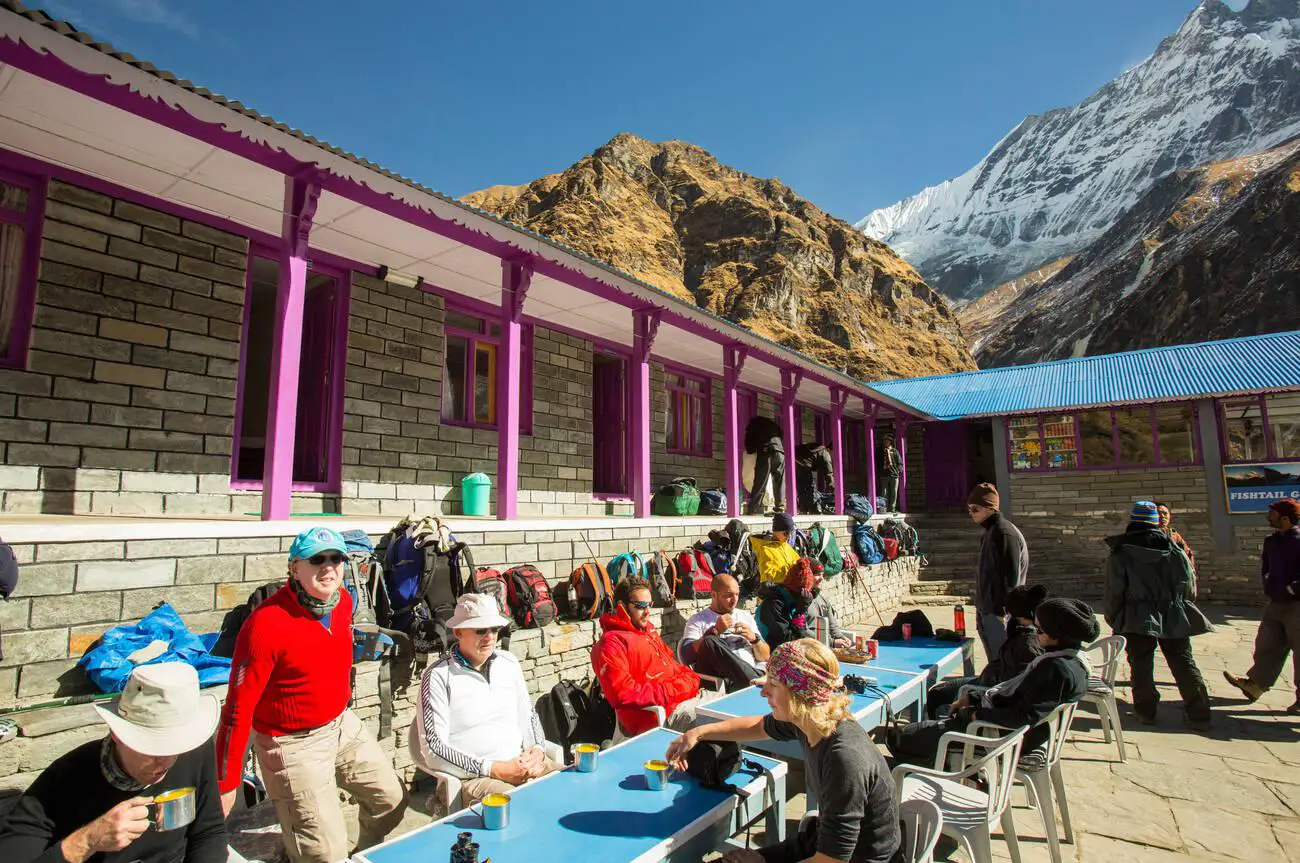
Safety and Preparation
Setting out on the Machhapuchhre Base Camp trek demands careful preparation and a strong focus on safety. Being well-prepared physically and having the right gear can transform a challenging trek into a rewarding adventure while minimizing potential risks.
Physical Preparation
- Conditioning: Begin your training months in advance. Enhance your endurance by incorporating cardiovascular activities like running, cycling, and swimming into your daily exercise regimen.
- Strength Training: Concentrate on strengthening your legs with exercises like squats, lunges, and stair climbing, which are crucial for demanding treks.
- Hiking Practice: Regularly hike on various terrains to condition your body for extended walks, and include hill walking to mimic the trek’s uphill challenges.
Essential Gear and Supplies
- Footwear: Choose high-quality, well-broken-in hiking boots to prevent blisters and ensure durability.
- Clothing: Prepare for “Machapuchare base camp weather” by packing layers, including moisture-wicking base layers, insulation, and a waterproof exterior.
- Navigation Tools: Take a dependable map, compass, or GPS device, vital for navigating the complex “Machapuchare base camp route distance.”
- Health and Safety Items: Pack a first-aid kit, water purification solutions, sunscreen, and sunglasses, and consider altitude sickness medication due to the “Machapuchare base camp altitude.”
- Nutrition: Carry energy-boosting snacks such as nuts, dried fruits, and energy bars to sustain you through the long trekking days.
Cultural Significance
It is more than a destination for trekkers; it is a culturally significant site within the Annapurna region, where respect for local traditions enhances the trekking experience.
Integration into Local Culture
- Spiritual Significance: The local communities regard Machapuchare as sacred, believing it to be a deity’s abode. Consequently, climbing the mountain is respectfully prohibited to honor its sanctity.
- Architectural and Cultural Insights: The architecture in the villages along the trek, featuring slate roofs and intricately carved wooden windows, showcases traditional Himalayan styles.
Interactions with Local Communities
- Homestays and Teahouses: Choosing homestays and teahouses allows you to engage directly with the everyday lives of mountain communities, support the local economy, and experience genuine hospitality.
- Cultural Exchange: Respectfully engaging with locals lets you gain a deeper understanding as they share their traditions and lifestyles.
- Support Local Crafts: Support local artisans by purchasing handicrafts like handwoven shawls or handmade jewelry to help preserve the area’s artistic heritage.

Conservation Efforts in the Annapurna Region
Trekking to Machhapuchhre Base Camp offers stunning vistas and a chance to contribute to significant conservation efforts safeguarding the Annapurna region’s beauty. Embracing environmental sustainability and eco-friendly practices is vital to preserving this pristine area.
Addressing Environmental Concerns
Due to increased tourism, the Annapurna region contends with severe environmental challenges, including deforestation, waste management problems, and biodiversity reduction. These issues demand continuous efforts to sustain the natural habitat and its biodiversity.
Driving Conservation Initiatives
- Waste Reduction Programs: Initiatives that significantly promote waste collection and recycling reduce the impact of trekker-generated waste. Encouraging trekkers to remove their trash has proven beneficial.
- Adopting Sustainable Practices: Many local teahouses and lodges now employ solar energy and other sustainable methods to lessen their environmental impact.
- Engaging Local Communities: Effective conservation initiatives engage local communities, providing training and employment, which nurtures a conservation-oriented mindset.
Guidelines for Responsible Trekking
- Reduce Waste: Always remove what you bring, opt for reusable items, and steer clear of single-use plastics.
- Respect Trails: Maintain the local flora by adhering to established trails and avoiding shortcuts that could harm the landscape.
- Support the Local Economy: Employ local guides and buy local products to foster sustainable economic development in the region.
Capturing the Beauty of MBC
The trek route to MBC presents unparalleled photographic opportunities that promise lifelong memories and stunning images.
Effective Photography Tips
- Optimize Lighting: Capture the most striking images during the early morning and late afternoon when the light is soft and dramatic.
- Choose Suitable Equipment: Invest in a high-quality camera and various lenses, from wide-angle to zoom, to capture expansive and detailed photographs.
- Ensure Stability: Use a tripod to stabilize your camera. This feature is helpful during long exposures in windy, high-altitude conditions.
Noteworthy Photogenic Spots
- Poon Hill: Poon Hill offers spectacular sunrise views over the Annapurna and Dhaulagiri ranges, earning it widespread acclaim.
- Annapurna Base Camp: Provides expansive views of the encircling Annapurna range.
- Ghandruk: Offers picturesque scenes of terraced fields and traditional Gurung village architecture set against towering mountains.
Conclusion
Trekking to Machhapuchhre Base Camp is an adventure you will always remember. It provides more than just a physical challenge; it invites you into the heart of Nepal’s stunning natural landscapes and rich cultural heritage. As you prepare for this trek, it is crucial to plan thoroughly and adopt practices that respect the environment and local traditions.
Highlights of the Trek
- Varied Landscapes: The trek to Machhapuchhre Base Camp takes you through lush forests, over rugged terrains, and beside glacial streams, showcasing the incredible diversity of nature. The trek, defined by the “Machapuchare base camp route distance,” offers breathtaking scenes that captivate and challenge trekkers.
- Cultural Immersion: As you traverse traditional villages, the warm hospitality of the Gurung and Magar communities awaits you. These interactions deepen your understanding of the local customs and enhance your overall experience.
- Physical and Spiritual Challenge: Achieving the “Machapuchare base camp altitude” of about 3,700 meters is a physical feat and a profound spiritual encounter, reflecting the sacred significance of Machapuchare in local traditions.
